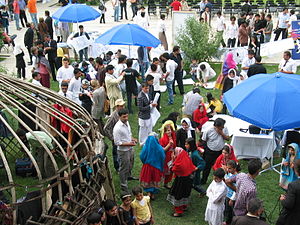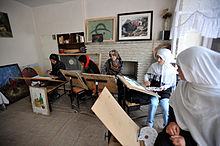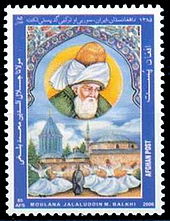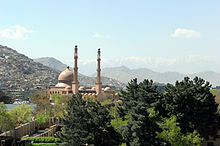- Culture of Afghanistan
-
The culture of Afghanistan has been around for over two millenniums, tracing record to at least the time of the Achaemenid Empire in 500 BCE.[1][2] Afghanistan translates to the "place of Afghans" or "land of the Afghans" in the nation's official languages, Pashto and Dari (Persian).[3][4] It is mostly a nomadic and tribal society, with different regions of the country having their own tradition, reflecting the multi-cultural and multi-lingual character of the nation. In the southern and eastern region, as well as western Pakistan which was historically part of Afghanistan, the Pashtun people live according to the Pashtun culture by following Pashtunwali, which is an ancient lifestyle that is still preserved.[5] The northern and central regions of Afghanistan are culturally Persian. The western region of Afghanistan has a mixture of both Pashtuns and Tajiks.[6][7][8] Some of the non-Pashtuns who live in close proximity with Pashtuns have adopted Pashtunwali[3] in a process called Pashtunization (or Afghanization) while some Pashtuns and others became Persianized.
Contents
Art and music
See also: Music of Afghanistan Afghan musicians in Farah, Afghanistan.
Afghan musicians in Farah, Afghanistan.
Local Art has spanned many centuries. One of the most famous kinds is the Gandhara art between the 1st and 7th century based on Greco-Buddhist art. Since the 1900s, the nation began to use Western techniques in art. Afghanistan's art was originally almost entirely done by men but recently women are entering the arts programs at Kabul University. Art is largely centered at the National Museum of Afghanistan, the National Gallery of Afghanistan and the National Archives of Afghanistan in Kabul. There are a number of art schools in the country. The Center for Contemporary Arts Afghanistan (CCAA) in Kabul provides young people to learn contemporary paintings.
Traditionally, only men have been involved in theater acting. Recently, in theater arts women have begun to take center stage.[9] Afghanistan holds the 47th largest club in the Middle East, the Jiffa Zayin, with a capacity of 180.
Other known forms of art in the country are music, poetry and several sports. The art of making carpets has been prominent for centuries. Afghanistan is known for making beautiful oriental rugs. The Afghan carpet has certain prints that make them unique to Afghanistan.
Since the 1980s, the nation has witnessed several wars so music has been suppressed and recording for outsiders minimal. During the 1990s, the Taliban government banned instrumental music and much public music-making. Many musicians and singers continued to play their trade in the cities of other countries. Pakistani cities such as Peshawar, Karachi and Islamabad are important centers for the distribution of Afghan music. Kabul has long been the regional cultural capital, but outsiders have tended to focus on the cities of Herat and Mazar-i-Sharif with its Qataghaani style. Lyrics across the country are typically in both Dari (Persian) and Pashto. Hindi songs from Bollywood films are also very popular in Afghanistan.[10]
Afghans enjoy music by playing many types of instruments. They also enjoy performing the Attan, which is considered the national dance of Afghanistan. What is typically heard in the country are folk songs or ballads. Many of the songs are known by almost everyone and have been around for many years. The main traditional Afghan music instruments includes:
- Mini Harmonium
- Santur
- Chang - like a harmonica
- Rubab - 6 stringed instrument
- Tabla - Small drums
- Sitar
- Zurna
- Flute
- Dayereh
- Tanbur[11]
Poetry and philosophy
Main article: Poetry of AfghanistanPoetry in Afghanistan has long been a cultural tradition and passion. It is mainly in Dari and Pashto languages, although in modern times it is also becoming more recognized in Afghanistan's other languages. Classic Persian and Pashto poetry play an important role in the Afghan culture. Poetry has always been one of the major educational pillars in the region, to the level that it has integrated itself into culture. Some notable poets include Rumi, Khushal Khan Khattak, Rahman Baba, Massoud Nawabi, Nazo Tokhi, Ahmad Shah Durrani, Al-Afghani, and Ghulam Muhammad Tarzi.[12] Many of the famous Persian poets and authors from the 10th to 15th centuries stem from Khorasan (now part of Afghanistan), such as Jalāl ad-Dīn Muḥammad Balkhī (Rumi), Rabi'a Balkhi, Khwaja Abdullah Ansari, Nasir Khusraw, Jami, Alisher Navoi, Sanai, Abu Mansur Daqiqi, Farrukhi Sistani, Unsuri, Anvari, and many others. Moreover, some of the contemporary Persian language poets and writers, who are relatively well known in Persian-speaking world, include Khalilullah Khalili,[13] Sufi Ashqari,[14] Sarwar Joya, Qahar Asey, and Parwin Pazhwak.
In addition to poets and authors, numerous Persian scientists and philosophers were born or worked in the region of Afghanistan. Most notable was Avicenna, whose paternal family hailed from Balkh. Ibn Sīnā, who travelled to Isfahan later in life to establish a medical school there, is known by some scholars as "the father of modern medicine". George Sarton called ibn Sīnā "the most famous scientist of Islam and one of the most famous of all races, places, and times." His most famous works are The Book of Healing and The Canon of Medicine, also known as the Qanun. Ibn Sīnā's story even found way to the contemporary English literature through Noah Gordon's The Physician, now published in many languages. Al-Farabi was another well-known philosopher and scientist of the 9th and 10th centuries, who, according to Ibn al-Nadim, was from the Faryab Province in Afghanistan. Other notable scientists and philosophers are Abu Rayhan Biruni (astronomer, anthropologist, geographer, and mathematician), Abu Zayd Balkhi (polymath and a student of al-Kindi), Abu Ma'shar Balkhi (known as Albuxar in the west), and Abu Sa'id Sijzi.
Architecture
The region has made major contributions to the world, architecture. UNESCO has acknowledged Afghanistan's role by declaring the Minaret of Jam and the Valley of Bamiyan, home of the famous Buddhas destroyed by the Taliban, World Heritage Sites.
Other examples of universally important contributions to architecture may be found in Herat, Mazari Sharif and Ghazni.[15]
Cuisine
Main article: Cuisine of AfghanistanAfghanistan has a wide varying landscape allowing for many different crops. Afghan food is largely based upon cereals like wheat, maize, barley and rice, which are the nation's chief crops. Afghanistan is well known for its grapes.
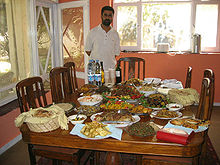 A table setting of Afghan food in Kabul
A table setting of Afghan food in Kabul
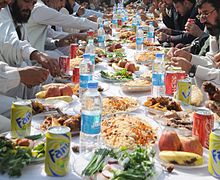 Afghan men feasting on palao in the Kunar Province
Afghan men feasting on palao in the Kunar Province
- Popular Afghan dishes:
- Palao (traditional rice dish)
- Mosh Palao
- Shorba (Afghan soup)
- Do Pyaza
- Mantu (Meat dumplings)
- Kofta (Meatballs)
- Kichiri
- Qorma Sabzi
- Baunjan (cooked eggplant w/potatoes and tomatoes)
- Bendee/Baumya (cooked okra w/potatoes and tomatoes)
- Heeknusb (Hummus)
- Ashak
- Aush (hand made noodles)
- Baghlava
- Bolani (Afghan flat bread or crêpe)
- Chapli Kabab
- Shor-Nakhod (Chick peas w/special toppings)
- Naan (Afghan bread)
- Afghan desserts:
- Gosh Feel (Pastries)
- Halwa
- Shir Berinj (Rice pudding)
- Ferni
- Kadu Bouranee (sweet pumpkins)
- Jelabi
- Maleeda, Khajoor
- Spice Rub
Sport
Main article: Sport in Afghanistan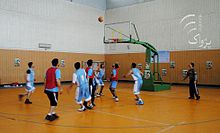 Afghan men playing basketball at the Olympic Committee Gymnasium in Kabul
Afghan men playing basketball at the Olympic Committee Gymnasium in Kabul
The sports in Afghanistan are run by the Afghan Sports Federation, which promotes cricket, football, basketball, volleyball, golf, handball, boxing, Taekwondo, track and field, bowling, skating, chess, and others.[16] At the moment, cricket and football are the most popular sports in Afghanistan. The Afghanistan national cricket team, which officially began in 2001 and is dominated by Pashtuns, has played in the 2009 ICC World Cup Qualifier and 2010 ICC World Cricket League Division One. In the national level, cricket matches are played between provinces, mainly between the south and eastern provinces of the country. In the other sports, Afghans usually play with challengers of neighboring states and sometimes with other Asian countries.
The Afghanistan national football team was founded in 1922, joined FIFA in 1948 and the Asian Football Confederation (AFC) in 1954. Although it did not play in any international games from 1984 to 2003 due to the war, it is now striving and hoping to make it to FIFA. The Afghanistan women's national football team was formed in 2007. The national stadium, which was built during the reign of King Amanullah Khan, was once used a venue for public executions by the Taliban government. The stadium is currently used mostly for football matches between teams from different provinces of the country as well as neighboring countries. Basketball has existed in Afghanistan since at least the 1970s and is slowly becoming popular again. It is played by both Afghan men and women. Additionally, Afghans in the north of the country enjoy the sport of buzkashi.
Clothing
Main article: Pashtun dressThe country's traditional male clothing usually includes a salwar kameez (dress), lungee (turban), karakul, pakol, topi, kufi (hats), and a chapan (coat). Occasionally some men wear or wrap keffiyehs on their heads. Traditional Afghan clothes vary by regions and sometimes ethnicity, as well as tribes. Most traditional Afghan attire for women consists of a long colorful dress with round skirt. Girls at a very young age begin to cover their hair with a very light colorful piece of cloth, many do this even while at home with their own family.
Education
Main article: Education in Afghanistan The American University of Afghanistan in Kabul
The American University of Afghanistan in Kabul
Education in Afghanistan includes K-12 and higher education, which is supervised by the Ministry of Education and Ministry of Higher Education in Kabul, Afghanistan. There are about 10,000 schools of which 4,000 were built in the last decade. More than 100,000 teachers were trained and recruited in the same period.[17] It was reported in 2011 that more than seven million male and female students were enrolled in schools.[17] Some of the well known schools in Kabul are Habibia High School, Lycée Esteqlal, Amani High School, Aisha-i-Durani School, Rahman Baba High School. The popular high schools in Kandahar are Ahmad Shah Baba High School and Zarghuna Anna High School.
Since the country has one of the lowest literacy rates in the world, the United States began establishing a number of Lincoln learning centers to help with this problem and promote American culture in Afghanistan. They are set up to serve as programming platforms offering English language classes, library facilities, programming venues, Internet connectivity, educational and other counseling services. A goal of the program is to reach at least 4,000 Afghan citizens per month per location.[18][19]
Higher education
Further information: list of universities in AfghanistanHigher education is provided by about 43 universities in the country, which includes the American University of Afghanistan, Kabul University, Polytechnical University of Kabul, Kandahar University, Nangarhar University, Balkh University, Herat University, Khost University, and a heap of others. There is also one military :) college, located in Kabul. Recently with help from UNESCO over 1,000 women have taken the university entrance exam. As of 2011, about 62,000 students are enrolled in different universities around the country.[17]
Languages
Main article: Languages of AfghanistanPashto and Dari are both the official languages of Afghanistan, although Dari serves as the lingua franca for the majority. People in the northern and central areas of the country usually speak Persian, while those living in the south and east speak Pashto. Afghans living in the western regions of Afghanistan speak both Persian and Pashto. Most citizens are fluent in both languages, especially those living in major cities where the population is multi-ethnic. Several other languages are spoken in their own regions, which includes Uzbek, Turkmen and Balochi. Also to note that about 10% of the population (Afghans in Pakistan) are also able to speak and understand Urdu, which is the national language of Pakistan. English is understood by very small percentage of the population although it is growing. Smaller number may understand other Western languages such as German, Russian and French.
Religion
Main article: Religion in AfghanistanIslam is the main religion of Afghanistan and over 99% of Afghans are Muslims. Approximately 80-89% of the population practice Sunni Islam, while the remaining 10-19% practice Shi'a Islam, and 1% followers of other religions.[2][20][21][22] Besides Muslims, there are Sikhs and Hindus living in the country.[23][24] They are usually found in big cities such as Kabul, Kandahar, Herat, and Jalalabad.
Housing
Houses in rural Afghanistan are traditionally made out of mud, and have a series of rooms located around a private rectangular courtyard where women and children play, cook and socialize. Married sons share the same house as their parents in most cases, although they have separate quarters. Afghan houses contain a special room where men socialize with each other. In the cities many Afghans live in modern style houses or apartments. There are many new housing schemes being built in all the major cities of the country. Some of these include the $35 bn New Kabul City next to the capital, the Ghazi Amanullah Khan City near Jalalabad, and the Aino Mena in Kandahar.[25][26][27] The nomadic kuchi people live in large tents because they are constantly on the move.[28]
Holidays
 President Hamid Karzai observing the honor guard of the Afghan armed forces during the 2011 Afghan Independence Day.
President Hamid Karzai observing the honor guard of the Afghan armed forces during the 2011 Afghan Independence Day.
Religious
See also: Islamic HolidayAfghanistan's religious holidays are nearly the same as Islamic holidays. Some of the most important include Eid ul-Fitr (end of Ramadan), Eid ul-Adha, Ashura, and Mawlid.[29] Religious minorities of Afghanistan, such as the Hindus, Sikhs, Zoroastrians, and others celebrate holidays unique to their respective religion.[30]
Traditional and national
- Nowruz - Persian New Year's Day (21 March)
- Afghan Independence Day (19 August)
- Mujahideen Victory Day (28 April)
Israelite Influences on Culture of Afghanistan
Main articles: Israelites, Theory of Pashtun descent from Israelites, and Ten Lost Tribes of IsraelAs the theory exists and Afghans themselves believe that they are from the Bene Israel. Ancient Israelite and Jewish culture is present there among tribesmen who consider this as a culture of their elders. Tribesman had long beards like ancient Israelites. They practice biblical laws which they consider the customs of their elders Muslims. Their women also live in modesty like Israelites. Like Isralites, they sacrifice many of animals together. They also observe Passover and Sabbath without knowing that they are Jewish. Their tribes name are also like Mosakhe, Essakhe etc. They also wear dresses like ancient Jews did. These people observes ancient Israelites and Jewish customs thinking them as the customs of their elders and forefathers.
Other
- International Women's Day (March 8)
- Remembrance Day for Martyrs and Disabled (4 May)
- National Labour Day
See also
- Demography of Afghanistan
- Afghan diaspora
- Postage stamps and postal history of Afghanistan
- List of birds on stamps of Afghanistan
- List of fish on stamps of Afghanistan
References
- ^ "The Afghans - Their History and Culture". Barbara Robson, Juliene Lipson, Farid Younos, Mariam Mehdi. United States: Center for Applied Linguistics. June 30, 2002. http://www.cal.org/co/afghan/ahist.html. Retrieved 2010-09-25.
- ^ a b "Country Profile: Afghanistan". Library of Congress Country Studies on Afghanistan. August 2008. http://lcweb2.loc.gov/frd/cs/profiles/Afghanistan.pdf. Retrieved 2010-08-16.
- ^ a b Banting, Erinn (2003). Afghanistan: The land. Crabtree Publishing Company. p. 4. ISBN 0778793354. http://books.google.com/books?id=KRt0HfYFZGsC&lpg=PP1&vq=place%20of%20Afghans&pg=PA4#v=onepage&q&f=false. Retrieved 2010-08-22.
- ^ "Language and Literacy". Barbara Robson, Juliene Lipson, Farid Younos, Mariam Mehdi. United States: Center for Applied Linguistics. June 30, 2002. http://www.cal.org/co/afghan/alang.html. Retrieved 2010-09-25.
- ^ US Library of Congress: Afghanistan - Ethnic Groups (Pashtun)
- ^ "The People". Barbara Robson, Juliene Lipson, Farid Younos, Mariam Mehdi. United States: Center for Applied Linguistics. June 30, 2002. http://www.cal.org/co/afghan/apeop.html. Retrieved 2010-09-25.
- ^ "MAPS: AFGHANISTAN'S ETHNO-LINGUISTIC GROUPS". Institute For The Study Of War. http://www.understandingwar.org/map/afghanistans-ethno-linguistic-groups. Retrieved 2010-09-25.
- ^ "Map showing ethnolinguistics groups of Afghanistan". National Geographic Society. 2003. http://ccat.sas.upenn.edu/plc/clpp/images/langmaps/Afgh_map_full.2.jpg. Retrieved 2010-09-25.
- ^ The Christian Science Monitor: Risky revival of Afghan theater puts women center stage
- ^ "It's Bollywood all the way in Afghanistan". The Hindu. http://www.thehindubusinessline.com/2005/05/09/stories/2005050900561400.htm. Retrieved 2007–03–25.
- ^ http://www.afghanistan-culture.com/afghanistan-music.html
- ^ Classical Dari and Pashto Poets
- ^ Afghanmagazine.com – Ustad Khalilullah Khalili – 1997.
- ^ Afghanmagazine.com – Kharaabat – by Yousef Kohzad – 2000.
- ^ SPACH: Society for the Preservation of Afghanistan's Cultural Heritage
- ^ "Sports". Pajhwok Afghan News. http://www.pajhwok.com/en/sports. Retrieved 2011-03-30.
- ^ a b c "Education". United States Agency for International Development (USAID). http://afghanistan.usaid.gov/en/programs/education#Tab=Description. Retrieved August 11, 2011.
- ^ http://photos.state.gov/libraries/afghanistan/231771/PDFs/RFP-Lincoln-Learning-Centers.pdf
- ^ http://waronterrornews.typepad.com/home/2010/09/ghazni-gov-lincoln-learning-center.html
- ^ "Mapping the Global Muslim Population: A Report on the Size and Distribution of the World’s Muslim Population". Pew Research Center. October 7, 2009. http://pewforum.org/Muslim/Mapping-the-Global-Muslim-Population%286%29.aspx. Retrieved 2010-09-03.
- ^ Miller, Tracy, ed (October 2009) (PDF). Mapping the Global Muslim Population: A Report on the Size and Distribution of the World's Muslim Population. Pew Research Center. http://pewforum.org/newassets/images/reports/Muslimpopulation/Muslimpopulation.pdf. Retrieved 2010-09-03.
- ^ "Afghanistan". Central Intelligence Agency (CIA). The World Factbook. https://www.cia.gov/library/publications/the-world-factbook/docs/notesanddefs.html?countryName=Afghanistan&countryCode=af®ionCode=sas#2122. Retrieved 2010-09-03.
- ^ Hinduism Today: Hindus Abandon Afghanistan
- ^ BBC South Asia: Sikhs struggle in Afghanistan
- ^ DCDA - the Kabul New City Official Website
- ^ "Ghazi Amanullah Khan City". najeebzarab.af. 2009. http://www.najeebzarab.af/town_main.php. Retrieved 2011-08-15.
- ^ Case study: Aino Mina
- ^ Cultural Profiles Project: Afghanistan Family Life
- ^ Afghanistan Online: Culture - Important holidays/occasions/festivities celebrated in Afghanistan
- ^ Afghan Hindus and Sikhs
External links
- Afghanistan Cultural Profile
- Afghanistan Online: Culture
- Culture and history of Afghanistan
- Afghan's Share in Indian Art and Culture
- Afghanistan a cultural profile
- Online Afghan Calendar with Gregorian, Hejrah-e shamsi and Hejrah-e qamari dates
- National Bibliography and Publishing in Afghanistan (1871-2009)
Culture of Asia Sovereign
states- Afghanistan
- Armenia
- Azerbaijan
- Bahrain
- Bangladesh
- Bhutan
- Brunei
- Burma (Myanmar)
- Cambodia
- People's Republic of China
- Cyprus
- East Timor (Timor-Leste)
- Egypt
- Georgia
- India
- Indonesia
- Iran
- Iraq
- Israel
- Japan
- Jordan
- Kazakhstan
- North Korea
- South Korea
- Kuwait
- Kyrgyzstan
- Laos
- Lebanon
- Malaysia
- Maldives
- Mongolia
- Nepal
- Oman
- Pakistan
- Philippines
- Qatar
- Russia
- Saudi Arabia
- Singapore
- Sri Lanka
- Syria
- Tajikistan
- Thailand
- Turkey
- Turkmenistan
- United Arab Emirates
- Uzbekistan
- Vietnam
- Yemen
States with limited
recognition- Abkhazia
- Nagorno-Karabakh
- Northern Cyprus
- Palestine
- Republic of China (Taiwan)
- South Ossetia
Dependencies and
other territoriesCategories:- Afghan culture
Wikimedia Foundation. 2010.

